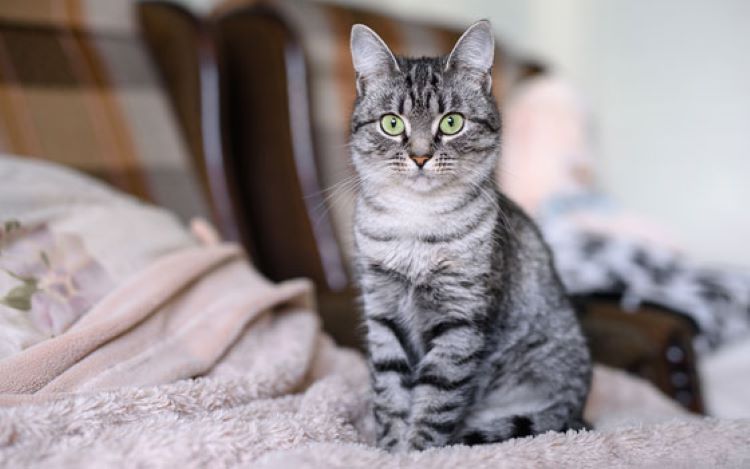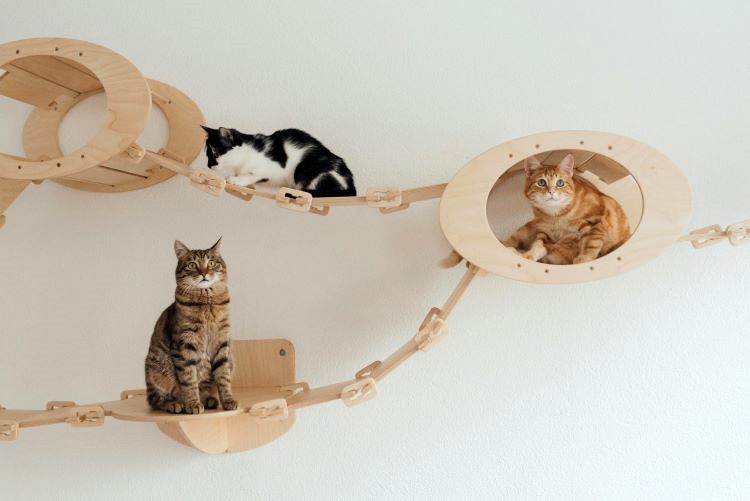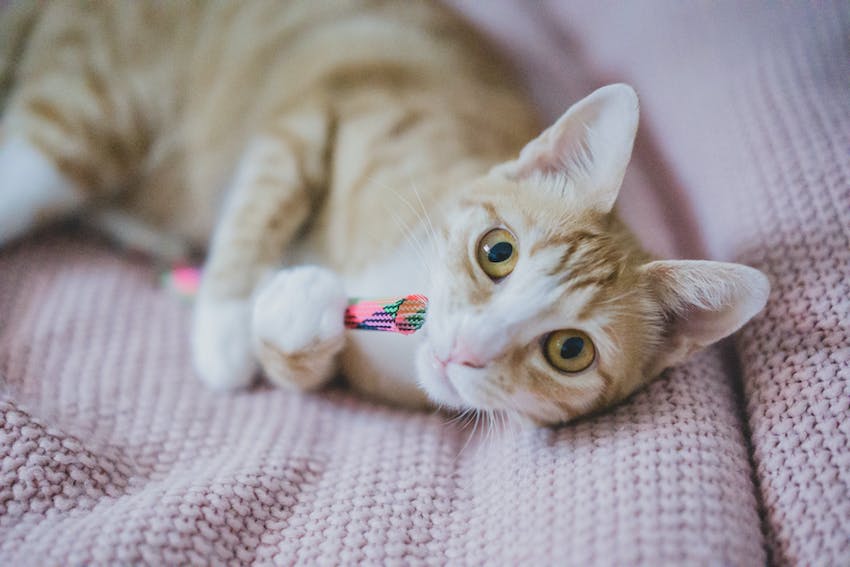Ready to help treat your pet to a healthy life?
What is a Domestic Shorthair Cat? A Guide to the 'Breed'
By : Trupanion Staff | Updated May 28, 2024

If you've heard of any type of cat, it's probably the Domestic Shorthair. Not only are they the most common kinds of cats in the United States and Canada, but they're prevalent around the world. Also referred to as "Domestic Short-haired cats" or sometimes just "DSH," these felines come in a huge variety of colors and have, as their name suggests, short fur. But are they even a real cat breed?
Despite their widespread popularity, these cats are often the target of misconceptions. If you're considering adopting one or want to learn more about the short-haired kitty in your family, it's important to be able to separate fact from fiction. In this in-depth look at Domestic Shorthairs, we'll explain what these cats are and cover their history, care tips, and more. Let's start with what they are.
What is a Domestic Shorthair Cat?
As mentioned above, Domestic Shorthair cats are one of the most common types of cats on the planet. In fact, any city with cats is almost certain to have Domestic Shorthairs. But to understand why this is, it's necessary to know what exactly these cats are.
The truth is that the DSH is not an actual cat breed itself. Instead, it's simply a type of cat characterized by its short, sleek coat and, very often, its unknown genetics (meaning it can't be assigned to any one specific breed of cat). Because Domestic Short-haired cats are a general category that do not belong to any particular breed, they are essentially mixed-breed cats. As a result, these kitties can be found in any color, color combination, or pattern that is seen in other cat breeds, from tabby to tuxedo to tortoiseshell, and beyond.
Interestingly, their coloring and look trend toward the most common coloring and body style of other pedigreed cats in their geographical area. For example, Domestic Shorthair cats in Asia quite often have Siamese coloring, while Domestic Shorthairs in the United States and the United Kingdom tend to have a larger, sturdier body and long, athletic legs.
5 fun facts about Domestic Shorthairs
- Kittens and cats of unknown lineage are commonly referred to as Domestic cats or Mixed Breed, further refined into categories based on length of fur: Domestic Shorthairs, Domestic Medium Hairs, and Domestic Long Hairs.
- Just because a Domestic cat doesn’t have an official pedigree doesn’t mean you can’t show them! The International Cat Association (TICA) allows cat owners to show their non-pedigreed cat, with judging based on condition, beauty, and “show presence.” The World Cat Federation and the International Feline Federation allow housecats to compete in shows as well.
- Domestic cats are the most popular cat in the United States and are a good choice for new cat owners. However, Domestic Medium Hairs are less common than the Domestic Shorthair and Domestic Long Hair type cats.
- Due to their varied lineage, the lifespans of these cats vary wildly, with general expectations anywhere between 10 and 17 years. That said, most Domestic Shorthairs have a high amount of genetic diversity compared to other cats of more established breeds, increasing the likelihood of reaching advanced age.
- These cats also vary greatly in size. Smaller Domestic Shorthairs can be under 10 lbs. (4.5 kg) while larger kitties in this category can be 22 lbs. (9.97 kg) or more!

Breed history
Because Domestic Short-haired have unknown mixed breed heritage, they have no definitive origin story. These kitties can be found all over the world. Throughout history, they’ve acted as workers and companions to their families. Arriving in America aboard the ships of the early settlers, including the Mayflower, these cats played an important role in the new world. They may have started out keeping rodents at bay for pioneers and shopkeepers but soon became a popular family pet.
According to data from the American Veterinary Medical Association, 25% of American households included a cat as of 2018, and this number has only grown in the 2020s. The Domestic Short Hair will no doubt continue to play a big role in cat culture and their prevalence in our daily lives.
Temperament
Domestic Short Hair cats vary in temperament and personality, depending on their genetics and learning experiences. You’ll find all “types” of these mixed breeds, which means there’s some kitty for everyone! In fact, they’re often the first cat for many owners, due to their prevalence in shelters and rescues.
When choosing a kitten or adult cat, make sure to look for a companion that fits in with your lifestyle. Domestic Short Hairs have varied lifestyle preferences. Some are content to lounge around with their human guardians with occasional short play sessions, some are independent and self-entertaining, and others are highly active, intelligent, and require constant physical and mental stimulation.
If you have a particular lifestyle you’d like to share with your furry friend, consider adopting an adult cat. Since they’ve already grown into their personalities, you can get a better sense of the lifestyle they’ll need.
Kittens (as a general guideline) tend to be active and playful but may mellow out or maintain their energy level as they get older. You never know what you’re going to end up with when you bring home a kitten! That’s part of the fun.
Common behavioral issues
While many Domestic Short Hair cats don’t exhibit behavior issues, they can crop up if cat guardians aren’t meeting the needs of their cat. Most common are house-soiling (especially if appropriate litter box setups are not provided and maintained); inter-cat aggression (if a slow-introduction process is not followed); and destructive behavior such as scratching furniture, knocking over objects, and counter-surfing (particularly if ways to alleviate boredom are not provided).
The potential for encountering these problems can be minimized or avoided by making sure your cats’ needs are being met. This means an appropriately clean place for elimination, territorial security, mental and physical exercise, and social interaction.
Cats are also known to exhibit behavioral issues or changes if they’re experiencing pain, discomfort, or medical problems. So it’s important to manage your kitty’s health with regular visits to the veterinarian. See more about caring for these cats in the Care Tips section below.
Do Domestic Shorthairs play well with others?
Depending on your cat’s personality, they may get along well (or not) with other kittens, adult cats, household pets, and people. It’s always best to introduce your cat to a potential new friend slowly, giving them a choice whether to interact, and providing positive reinforcement for positive interactions.
Take extra care in introducing cats to each other, as most cats require time to get to know a new feline companion. Introductions that are rushed can result in fighting or injuries, undesirable behaviors (such as house-soiling), and stress for both humans and animals.

Care tips
Responsible pet parenting of a Domestic Shorthair cat follows normal cat care tips. All cats need routine veterinary care, daily exercise, and a healthy diet. If you have one of these kitties in your home, it's important to meet their needs in all of these areas to promote their health and well-being. You'll also want to consider protecting them with a good cat health insurance plan in case of any surprise illnesses, injuries, chronic conditions, or accidents.
Exercise needs
The Domestic Short Hair cat needs enough exercise to stay healthy and trim, as well as preventing unwanted behavior problems. Provide them with sufficient playtime, areas to climb, and encourage them to follow you around the house (or leash train them for outside walks) to get their steps in every day.
Veterinarian tip
Cats like to climb and explore, which can be a great form of exercise. But mever leave your cat alone near an open window that doesn't have a secure screen. If it's on the first floor, your cat can get out of the house and get injured, lost or any of the other possible problems that outdoor cats face on a daily basis. If the window is on the second floor or above your cat is at risk of suffering from severe injuries of "high-rise syndrome," and you don't even need to live in a true high-rise building. The injuries of "high-rise syndrome" tend to be worst in falls from between the 2nd and 7th floors!
Mental enrichment
All cats require mental enrichment to keep their minds sharp and active. Boredom can cause stress, which results in behavior issues. To keep your kitten or adult cat from getting bored, make sure you provide them with plenty of toys, rotated regularly, to keep them novel and exciting; plenty of perching places to climb and explore; cozy nooks in which to take naps; windows from which to watch wildlife; play (using an interactive wand toy) providing an outlet for their instinctive predatory behaviors; and puzzle-solving opportunities (such as food puzzles). Depending on how inquisitive, motivated, and intelligent your cat is, you might also consider clicker-training tricks and commands.
Grooming
Although their genetics vary greatly, Domestic Shorthair cats typically have a dense, double coat of fur shorter than 1-inch long. Like cats of all breeds, they need regular maintenance to keep their coats healthy. Shorthairs need weekly brushing (more during seasonal shedding periods). This helps prevent matting and furballs.
While most are quite capable of keeping themselves clean, sometimes a bath is in order. Like all cats, the Domestic Short Hair cat requires regular nail trimming and teeth brushing to stay happy and healthy.
Domestic shorthairs in pop culture
Thanks to the huge popularity and prevalence of Domestic Short-haired cats, they've appeared all over human pop culture and possibly have since our entertainment and popular media started including pets. These cats have appeared in numerous movies, TV shows, magazines, and websites over time, and they've also been found in the arms of celebrities. Some of them have even become famous on their own!
Famous owners
Domestic Short-haired kitties have long been favorites of households, including famous ones! There have been numerous famous owners of these cats over the decades, including:
- Ian Somerhalder (Actor)
- Alison Brie (Actress)
- Freddie Mercury (Singer)
- Kirsten Dunst (Actress)
- Crystal Dunn (Soccer Player)
- Ernest Hemmingway (Author)
- Eartha Kitt (Actress)
- Valerie Bertinelli (Actress)
Famous Domestic Short-haired cats
In more recent years, Domestic Shorthairs have taken over the internet and developed followings for their adorable appearances and fun behaviors. Here are just some examples:
- Monty who teaches animals and humans it’s ok to look different
- Venus the beautiful “two-faced” chimera cat
- Lil Bub, an internet celebrity Domestic Shorthair famous for her unique appearance caused by genetic mutation.
- Sam the cat with eyebrows
- Bob the street cat
